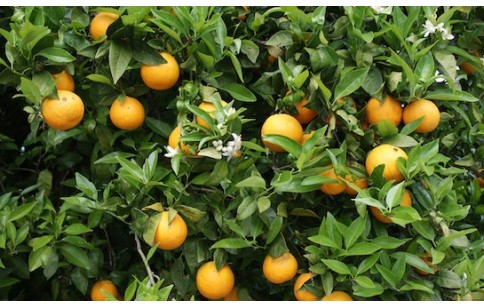- Code : #0552 S 20 mg
- Formula : C₁₂H₈O₄
- CAS : 484-20-8
Citrus aurantium
Citrus aurantium, “Bitter orange” or “Seville orange” in English, “Bigaradier” or “Oranger amer” in French, belongs to the Rutaceae botanical family.
This citrus tree, native to Southeast Asia (Chinese and Myanmar), is cultivated in Southern Europe and in regions with a subtropical climate.
The fruit and its dried peel are used in cooking (beverages, marmalade, breads…). Its essential oil is used as a flavouring and aromatic ingredient.
In folk medicine, the flowers are used as a mild sedative. The main constituents of the flowers’ essential oil (0.2 to 0.5%) are different monoterpenes, methyl anthranilate, bitter substances and flavonoids.
The unripe fruit and the dried peel are both used to treat gastric hypo-acidity. Their main constituents are: bitter-tasting flavonoid glycosides such as neohesperidin and naringin; non-bitter flavonoids; essential oil with mainly limonene, sabinene; pectin and furanocoumarins (bergapten).

- Code : #6034 S 20 mg
- Formula : C₉H₈O₄
- CAS : 331-39-5
- Code : #B9040 5 g
- Code : #5021 100 mg
- Formula : C₁₅H₂₆O
- CAS : 4602-84-0
- Code : #5024 S 100 mg
- Formula : C₁₂H₂₀O₂
- CAS : 105-87-3
- Code : #1116 S 20 mg
- Formula : C₂₈H₃₄O₁₅
- CAS : 520-26-3
- Code : #5082 S 100 mg
- Formula : C₁₀H₁₆
- CAS : 5989-27-5
- Code : #5041 S 100 mg
- Formula : C₁₀H₁₈O
- CAS : 78-70-6
- Code : #5004 S 100 mg
- Formula : C₁₂H₂₀O₂
- CAS : 115-95-7
- Code : #1129 S 20 mg
- Formula : C₂₇H₃₂O₁₄
- CAS : 10236-47-2
- Code : #1131 S 10 mg
- Formula : C₂₇H₃₂O₁₅
- CAS : 13241-32-2
- Code : #1132 S 10 mg
- Formula : C₂₈H₃₄O₁₅
- CAS : 13241-33-3
- Code : #5441 S 100 mg
- Formula : C₁₀H₁₆
- CAS : 18172-67-3
- Code : #5062 SA 100 mg
- Formula : C₁₀H₁₆
- CAS : 3387-41-5
- Code : #5077 S 100 mg
- Formula : C₁₀H₁₈O
- CAS : 98-55-5
















